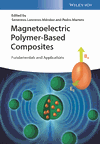Polymer-Based Magnetoelectric Composites: Polymer as a Binder
Polymer-Based Magnetoelectric Composites: Polymer as a Binder
Summary
Polymer-bonded (based) magnetoelectric (ME) composites are highly flexible, nonbrittle, and allow simple manufacturing processes at room temperature with various shapes and sizes. This chapter introduces representative results of polymer-based (polymer as a binder) Tb1-xDyxFe2-y/Pb(Zr, Ti)O3 ME composites to show how they are made and their structural design is improved. It then describes single- and multi-electrode cylindrical ME composite, and discusses the effects of polymer content and particle size on the composites. All studies utilized Tb1-xDyxFe2-y(Terfenol-D) and Pb(Zr, Ti)O3 (PZT) as the piezomagnetic (PM) and piezoelectric (PE) phases, respectively. The chapter further describes fabrication of ME composites laminated with the bonded Terfenol-D prepared by magnetic warm compaction and PZT ceramics, and measurement of the ME voltage coefficient of the composites. It proposes ME composite with multifaceted structure. The ME effect of this kind of composite has been further improved by using the multifaceted structure scheme.



